An asset can be connected to a reference. A reference to an asset provides information about the asset, such as the price of one unit in the asset. A reference is provided by a reference source. In order to view the references in OmniValue, select menu Program->References... The following dialog will be shown:
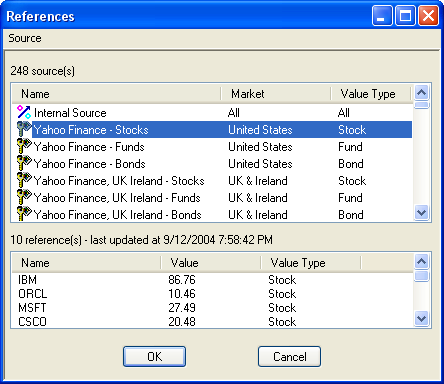
The top part of the dialog contains a list of all reference sources that are available in the program. The first column shows the name of the source, the second column the market where the references are traded (usually a country), and the third column the type of value that is referenced by the source. A source can only provide references of a specific value type (except for the internal source which can provide references for all value types).
The list of reference sources can be sorted by clicking on the column headers of the list. For example, to sort the reference sources by market, click on the column header for Market.
At the bottom of the dialog, a list of all references that are available for the currently selected source is shown.
There are different types of reference sources available in Milliplex OmniValue:
A Local List is a text file on the local computer containing a table where the name of the reference is listed in one column, and the price is listed in a different column. The columns must be separated by a designated separator character (usually a comma). An example of the format of such a text file is:
"IBM",86.76,"9/12/2004" "Oracle",10.46,"9/12/2004" "Microsoft",27.49,"9/12/2004" "Intel",20.53,"9/12/2004" "Cisco",20.48,"9/12/2004"
Here, the name of the reference is listed in column 1, and the price is listed in column 2. This type of file may be defined by the user himself, either by hand, or by using e.g. a spreadsheet application such as Microsoft Excel. Sometimes this type of file may also be supplied by a financial institution e.g by a stock exchange.
In order to use a text file as a local list source in Omnivalue, create a new reference source by selecting menu Source->New... (from the menu in the Reference dialog, not in the main view):
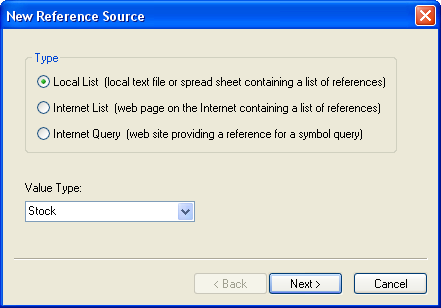
In the first step, the type of reference source must be defined, and the value type of the references. Here, the type Local List is selected, and the value type is set to Stock. Click on Next to go to the next step of the wizard:
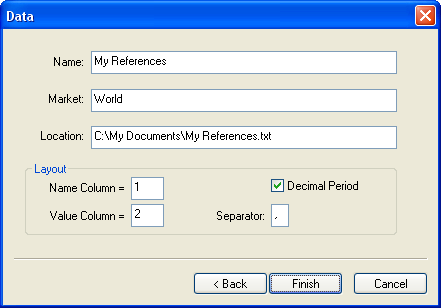
In the next step data for the reference source must be defined. In this example, the source is named "My References", the market is defined as "World", the location for the source is "C:\My Documents\My References.txt", the name of a reference is listed in the first column, and the price in the second column. A period is used as decimal. The separator used in the text file is a comma. After having defined these settings, click on Finish to create the reference source.
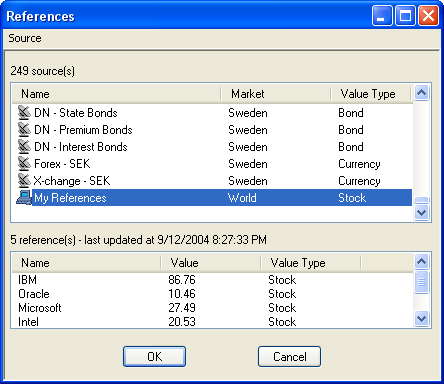
Before references from the source "My References" can be used in the program, the source must be updated. Select menu Source->Update in the dialog. After the update, the references that were defined in the text file will now show in the list for references.
An Internet Query is a web site on the Internet which provides a text file (spread sheet) with data for a single reference in response to a query with a symbol name. The text file has the same format as described in the section for the local list. In order to use a web site as an internet query in OmniValue, create a new reference source by selecting Source->New from the menu in the dialog:
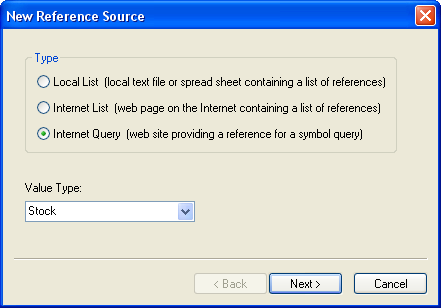
In the first step, the type of reference source must be defined, and the value type of the references. Here, the type Internet Query is selected, and the value type is set to Stock. Click on Next to go to the next step of the wizard:
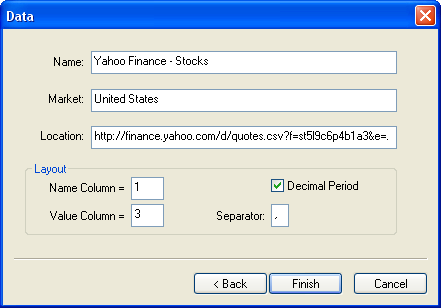
In the next step data for the reference source must be defined. In this example, Yahoo Finance is used as a source. The market is defined as United States. The location for an Internet Query is the part of the URL which does not contain the symbol identifier. Before making a query, OmniValue will append a symbol to the URL and then make the request. In the response from the source, the name of the reference is listed in column 1, the value in column 3, a period is used as a decimal, and the separator is a comma.
The location for an Internet Query may also contain additional URLs to a page for searching symbols based on company name, and for a bookmark page (usually a page with detailed information of the reference). The order of the URLs in a Query location field is:
The URLs are separated by semikolon. After having defined these settings, click on Finish to create the reference source.
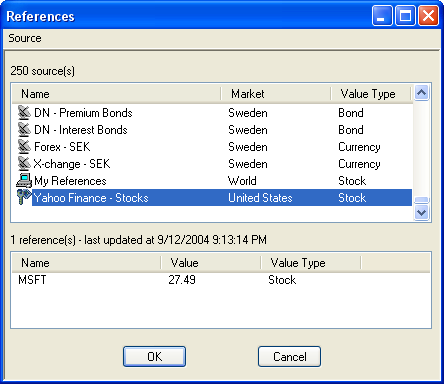
In order to update Yahoo Finance select Source->Update from the menu. An internet query must always be supplied with a reference symbol (ticker) before an update can be made. In this example, the reference symbol MSFT is used. After the update the symbol is available in the list of references.
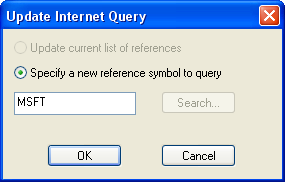
An Internet List is a web page on the Internet containing a table where the name of the reference is listed in one column, and the present value is listed in a different column. In order to use a web page as an internet list source create a new reference source by selecting Source->New from the menu in the dialog:
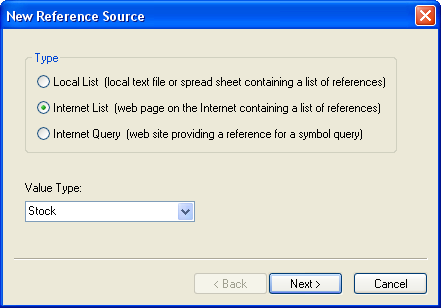
In the first step, the type of reference source must be defined, and the value type of the references. Here, the type Internet List is selected, and the value type is set to Stock. Click on Next to go to the next step of the wizard:
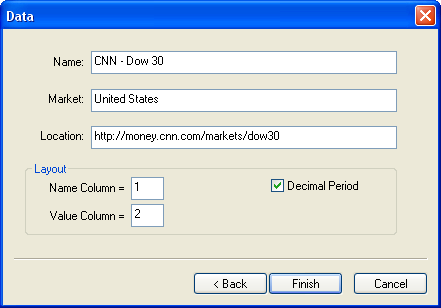
In the next step data for the reference source must be defined. In this example, a list from CNN is used. The source is named "CNN - Dow 30", the market is defined as "United States", the name of a reference is listed in the first column, and the value in the second column. A period is used as decimal. After having defined these settings, click on Finish to create the reference source.
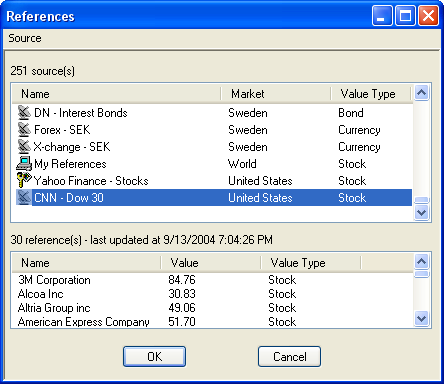
Before references from the source "CNN - Dow 30" can be used in the program, the source must be updated. Select menu Source->Update in the dialog. After the update, the references provided on the web page will now show in the list for references.
The Internal Source is an internal database in OmniValue which stores references to all assets that were created without a reference. This makes it possible to update the price of an asset from a reference in the internal source, rather than having to edit individual instances of the asset in different documents.
To update the internal source, select the Internal Source in the list of sources, and select Source->Update from the menu in the dialog.
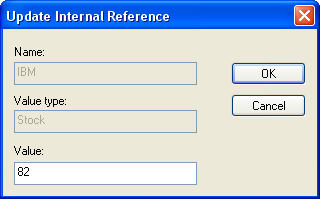
The update process will iterate through all internal references, showing an update dialog for each reference.
In order to facilitate a free and simple distribution of new or updated source definitions, either from Milliplex or from other users, sources can be exported and imported in the dialog for references. Select menu Source->Export... in the dialog to export a reference source to file. Select menu Source->Import... in the dialog to import a reference source from a file.
If a reference source contains references even though the source is not used, the references can be removed by selecting Source->Clear from the menu in the dialog. Clearing a reference source will also exclude the source from the initial cache update when starting OmniValue. As a result program start up time may be faster, if there are many unused active sources.
If a new reference source shall be created which has the same properties as an existing source, with the exception that the provided references are of a different value type, the menu Source->Clone... can be used to create a clone of the existing reference source. A clone must either have a different name, or a different value type.
The reference sources in OmniValue are periodically "synchronized" with new and updated definitions in an online web repository at Milliplex. This synchronization is done automatically by the program every 30 days. The synchronization can also be done at any time in the dialog for References. Select menu Source->Synchronize... to synchronize reference sources to current definitions by Milliplex.
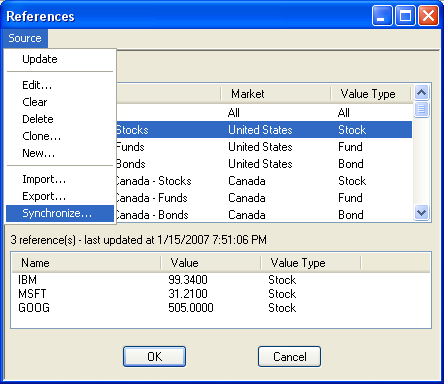
Note! Do not confuse Source Update with Source Synchronize. Source Update gets the actual price quotes for securities whereas Source Synchronize verifies the configuration of the source itself.
© Milliplex